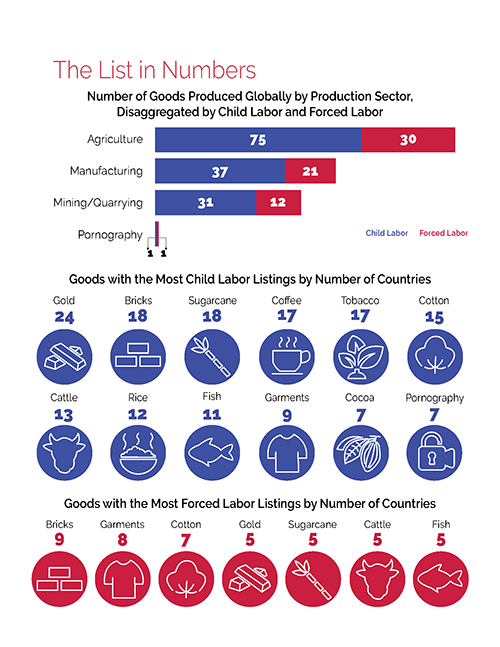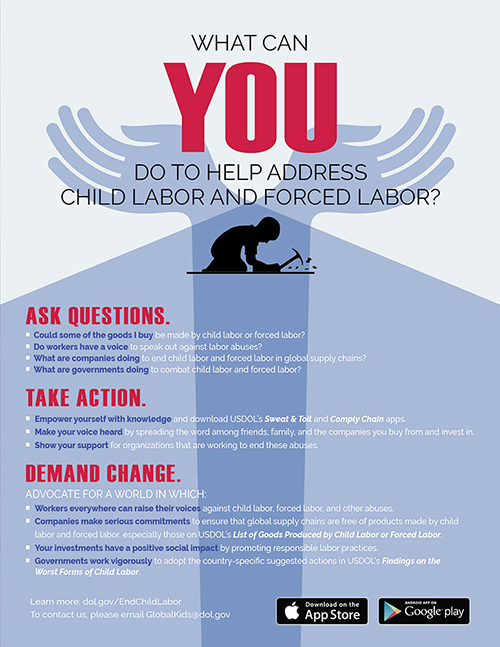List of Goods Produced by Child Labor or Forced Labor
The Bureau of International Labor Affairs (ILAB) maintains a list of goods and their source countries which it has reason to believe are produced by child labor or forced labor in violation of international standards, as required under the Trafficking Victims Protection Reauthorization Act (TVPRA) of 2005 and subsequent reauthorizations. The List of Goods Produced by Child Labor or Forced Labor comprises 159 goods from 78 countries and areas, as of September 28, 2022.
ILAB maintains the List primarily to raise public awareness about forced labor and child labor around the world and to promote efforts to combat them; it is not intended to be punitive, but rather to serve as a catalyst for more strategic and focused coordination and collaboration among those working to address these problems.
Publication of the List has resulted in new opportunities for ILAB to engage with foreign governments to combat forced labor and child labor. It is also a valuable resource for researchers, advocacy organizations and companies wishing to carry out risk assessments and engage in due diligence on labor rights in their supply chains.
The countries on the List span every region of the world. The most common agricultural goods listed are sugarcane, cotton, coffee, tobacco, cattle, rice, and fish. In the manufacturing sector, bricks, garments, textiles, footwear, carpets, and fireworks appear most frequently. In mined or quarried goods, gold, coal and diamonds are most common.
ILAB published the initial TVPRA List in 2009 and updated it annually through 2014, following a set of procedural guidelines that were the product of an intensive public consultation process. ILAB now updates and publishes the List every other year, pursuant to changes in the law.
Procedural Guidelines
On January 25, 2024, ILAB's Office of Child Labor, Forced Labor, and Human Trafficking published Procedural Guidelines for the development and maintenance of the List of Goods from countries produced by child labor or forced labor in violation of international standards.
| Country/Area | Good | Exploitation Type |
|---|---|---|
| Indonesia | There are reports that adult workers are forced to work in the production of palm oil in Indonesia. The palm oil industry is labor-intensive and employs between 3.7 million and 8 million workers. According to local media and NGO reports, thousands of individuals have been subjected to forced labor in the production of palm oil. Many of the workers on palm oil plantations are internal migrants within Indonesia, some of whom had to pay high recruitment fees leading to debt. It is widely reported that palm oil harvesters’ daily targets, which are set by companies, are unachievable within a 7-hour workday, compelling workers to work several hours beyond what the law permits without overtime pay because they fear steep deductions in wages if they do not meet their targets. Individuals work in remote, isolated plantations with limited freedom of movement and communication. Victims and local NGOs report that some workers who live on the plantation experience degrading living conditions, with no access to clean water or latrines. Some workers who work with hazardous pesticides and fertilizers are not provided with personal protective equipment, and they experience health problems and increased risks of injury from exposure to dangerous chemicals. |
Child Labor, Forced Labor |
| Malaysia | Child Labor, Forced Labor | |
| Sierra Leone | Child Labor |
your hand? Download ILAB's Sweat & Toil App today!
Are you a company looking to fight child labor and forced labor in supply
chains?





